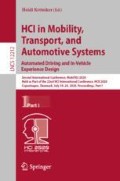Abstract
This study aimed to test collision avoidance systems in on-road environments and analyze drivers’ visual behaviors caused by the warnings from such systems through an on-road field operational test. Most previous driving studies related to collision warnings were done in driving simulators or closed-course test tracks. Recently, the need to study drivers’ responses in on-road environments is growing in order to improve the effectiveness of the collision warnings from advanced driver assistance systems (ADAS). In this study, drivers drove a car along an open road. Their perceptual attention and driving behaviors were analyzed by using video data and an eye-tracking device. The results from the eye movement data showed that the existence of the visual warning and the location of ADAS monitor significantly influence drivers’ warning perception. The findings of this study showed that understanding how the warnings from ADAS devices influence drivers’ visual behavior and driving safety in a driving environment is important to improve the benefits of using collision avoidance systems.
Access this chapter
Tax calculation will be finalised at checkout
Purchases are for personal use only
References
Abe, G., Richardson, J.: The influence of alarm timing on driver response to collision warning systems following system failure. Behav. Inf. Technol. 25(5), 443–452 (2006)
Bakowski, D.L., Davis, S.T., Moroney, W.F.: Reaction time and glance behavior of visually distracted drivers to an imminent forward collision as a function of training, auditory warning, and gender. Procedia Manuf. 3, 3238–3245 (2015)
Fisher, D.L., Nodine, E., Lam, A., Jerome, C., Monk, C., Najm, W.: Effects on drivers’ behavior of forward collision warning system alerts. Paper Presented at the Proceedings of the Human Factors and Ergonomics Society Annual Meeting (2016)
Gaspar, J., Brown, T., Schwarz, C., Chrysler, S., Gunaratne, P.: Driver behavior in forward collision and lane departure scenarios (0148–7191) (2016). Retrieved from
Hoover, R.L.D., Rao, S.J., Howe, G., Barickman, F.S.: Heavy-vehicle lane departure warning test development (2014). Retrieved from
Hopstaken, J.F., van der Linden, D., Bakker, A.B., Kompier, M.A., Leung, Y.K.: Shifts in attention during mental fatigue: evidence from subjective, behavioral, physiological, and eye-tracking data. J. Exp. Psychol. Hum. Percept. Perform. 42(6), 878 (2016)
Maltz, M., Shinar, D.: Imperfect in-vehicle collision avoidance warning systems can aid drivers. Hum. Factors J. Hum. Factors Ergon. Soc. 46(2), 357–366 (2004)
Meng, F., Gray, R., Ho, C., Ahtamad, M., Spence, C.: Dynamic vibrotactile signals for forward collision avoidance warning systems. Hum. Factors J. Hum. Factors Ergon. Soc. 57, 329–346 (2014). 0018720814542651
Palinko, O., Kun, A.L., Shyrokov, A., Heeman, P.: Estimating cognitive load using remote eye tracking in a driving simulator. Paper Presented at the Proceedings of the 2010 Symposium on Eye-Tracking Research & Applications (2010)
Savage, S.W., Potter, D.D., Tatler, B.W.: Does preoccupation impair hazard perception? A simultaneous EEG and eye tracking study. Trans. Res. Part F: Traffic Psychol. Behav. 17, 52–62 (2013)
Yan, X., Xue, Q., Ma, L., Xu, Y.: Driving-simulator-based test on the effectiveness of auditory red-light running vehicle warning system based on time-to-collision sensor. Sensors 14(2), 3631–3651 (2014)
Yang, X., Kim, J.H.: The effect of visual stimulus on advanced driver assistance systems in a real driving. Paper Presented at the Proceedings of the IIE Annual Conference (2017)
Yang, X., Kim, J.H., Nazareth, R.: Hierarchical task analysis for driving under divided attention. Paper Presented at the Proceedings of the Human Factors and Ergonomics Society Annual Meeting (2019)
Acknowledgments
Missouri Employers Mutual provided funding for this project.
Author information
Authors and Affiliations
Corresponding author
Editor information
Editors and Affiliations
Rights and permissions
Copyright information
© 2020 Springer Nature Switzerland AG
About this paper
Cite this paper
Kim, J.H. (2020). The Effects of Collision Avoidance Warning Systems on Driver’s Visual Behaviors. In: Krömker, H. (eds) HCI in Mobility, Transport, and Automotive Systems. Automated Driving and In-Vehicle Experience Design. HCII 2020. Lecture Notes in Computer Science(), vol 12212. Springer, Cham. https://doi.org/10.1007/978-3-030-50523-3_21
Download citation
DOI: https://doi.org/10.1007/978-3-030-50523-3_21
Published:
Publisher Name: Springer, Cham
Print ISBN: 978-3-030-50522-6
Online ISBN: 978-3-030-50523-3
eBook Packages: Computer ScienceComputer Science (R0)

